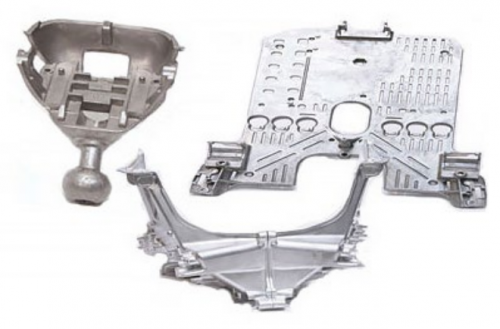Origin Article : https://www.diecastingdesign.org/blog/advancements-in-die-casting/
HPDC in the Automotive Industry
There are several reasons HPDC is a popular method within the automotive industry. For starters, automotive designers quickly realized the potential in HPDC based on its ability to successfully achieve crash and safety-critical application requirements. HPDC also helps the growing interest in overall improved consumption by reducing weight of vehicles.
Other benefits of HPDC in automotive applications include dimensional repeatability, cost-efficiency and superior finish.
Growing List of Alloys

Major alloys that account for most of the die castings produced in North America today are aluminum, magnesium, zinc and zinc aluminum. Alloys specifically designed for use in die casting have evolved greatly over time. The original three materials used in die casting were lead, tin and zinc, each of which are still used today. These materials have low melting points and high malleability, while aluminum and magnesium are lighter than steel and have high strengths and strength-to-weight ratios.
One material that has recently been added to die casting alloys is strontium. This highly reactive metallic element protects against die soldering, allows for reduction in iron levels and strengthens die cast aluminum. Another newer alloy suited to HPDC automotive application is A380, which features more elongation than other alloys. It is a low iron, high copper alloy to which strontium can be added, and it possesses good tensile, yield, impact and sheer strengths.
Newer forms of die casting technologies and variant procedures include squeeze casting, semi-solid metal casting and vacuum die casting, all of which are implemented to manufacture a near infinite array of parts for many different industries.
About NADCA
The North American Die Casting Design Association is proud to have funded research and development that have led to the discovery of aluminum alloy A380. NADCA is committed to providing useful resources related to product specification standards for die casting along with many other educational materials to aid in the designing of an optimized die cast product.
Download our eBook, Die Casting Advancements,for more information on the latest technological advancements of die cast products.
HPDC in the Automotive Industry
2008 년의 대 불황 이후 고압 다이캐스팅 (HPDC)에 대한 응용 프로그램이 크게 급증했습니다. HPDC는 다목적성, 정확성 및 반복성 덕분에 가장 널리 사용되는 금속 성형 공정 중 하나입니다. 자동차 산업은 다이캐스팅 산업의 현재 생산량의 절반 이상을 차지합니다.
자동차 산업의 HPDC
HPDC가 자동차 산업에서 널리 사용되는 것은 몇 가지 이유가 있습니다. 우선, 자동차 설계자는 충돌 및 안전에 중요한 애플리케이션 요구 사항을 성공적으로 달성 할 수 있는 능력을 바탕으로 HPDC의 잠재력을 빠르게 깨달았습니다. HPDC는 또한 차량 무게를 줄임으로써 전반적인 연비 개선에 도움이 됩니다.
자동차 응용 분야에서 HPDC의 다른 이점으로는 치수 반복성, 비용 효율성 및 우수한 마감 처리가 있습니다.
합금 목록 증가

오늘날 북미에서 생산되는 다이 캐스팅의 대부분을 차지하는 주요 합금은 알루미늄, 마그네슘, 아연 및 아연 알루미늄입니다. 다이캐스팅에 사용하기 위해 특별히 설계된 합금은 시간이 지남에 따라 크게 발전했습니다. 다이캐스팅에 사용된 원래 세 가지 재료는 납, 주석 및 아연이었으며, 각각은 오늘날에도 여전히 사용되고 있습니다. 이 재료는 융점이 낮고 가단성이 높은 반면 알루미늄과 마그네슘은 강철보다 가볍고 강도와 강도 대 중량 비율이 높습니다.
최근 다이캐스팅 합금에 추가된 한 가지 재료는 스트론튬입니다. 이 고 반응성 금속 요소는 다이 솔더링을 방지하고 철 수준을 낮추며 다이캐스트 알루미늄을 강화합니다. HPDC 자동차 응용 분야에 적합한 또 다른 새로운 합금은 A380으로, 다른 합금보다 연신율이 더 높습니다. 스트론튬을 첨가 할 수 있는 저 철분, 고구리 합금으로 인장, 수율, 충격 및 전단강도가 우수합니다.
새로운 형태의 다이 캐스팅 기술 및 변형 절차에는 스퀴즈 캐스팅, 반고체 금속 캐스팅 및 진공 다이 캐스팅이 포함되며,이 모두는 다양한 산업에서 거의 무한대로 배열 된 부품을 제조하기 위해 구현됩니다.